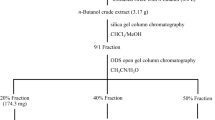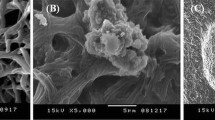Abstract
An actinomycete strain designated TN82 was isolated from Tunisian Sahara soil and selected for its interesting antimicrobial activity against Gram positive and Gram negative bacteria and fungi. Based on the results of cultural characteristic, the 16S rRNA gene nucleotide sequence (1434 bp, accession n° LT608133) and the phylogenetic analysis, this new isolate was assigned as Streptomyces sp. TN82 strain. Two active compounds, 3-phenylpyrazin-2(1H)-one (1) and 3-O-methylviridicatin (2), described for the first time as natural product and bacterial compound respectively, together with four known bacterial metabolites; cyclo-(Leu, Pro) (3), anthranilic acid (4), indole-3-carbaldehyde (5) and p-hydroxybenzoic acid (6) were isolated from the culture broth of this strain. Structure of the natural compound (1) was confirmed by extensive 1D and 2D NMR and EI MS and ESI HR mass measurements, and by comparison with literature data. Minimum inhibitory concentrations of the two compounds (1) and (2) against the tested human pathogenic bacteria S. aureus, L. monocytogenes and S. typhimurium were significantly lower than those of kanamycin. For the natural compound 3-phenylpyrazin-2(1H)-one (1), MICs values were very interesting especially that against L. monocytogenes (1.0 μg/mL) which is 2 and 12 times lower than those of ampicillin (2.0 μg/mL) and kanamycin (12.50 μg/mL), respectively.



Similar content being viewed by others
References
Anderson AS, Wellington EMH, Elizabeth MH (2001) The taxonomy of Streptomyces and related genera. Int J Syst Evol Microbiol 51:797–814
Anderson NA (1982) The genetics and pathology of Rhizoctonia solani. Annu Rev Phytopathol 20:329–347
Austin DJ, Meyers MB (1964) 3-O-methylviridicatin, a new metabolite from Penicillium puberulum J Chem Soc 1:1197–1198
Ben Ameur Mehdi R, Sioud S, Fourati Ben Fguira L, Bejar S, Mellouli L (2006) Purification and structure determination of four bioactive molecules from a newly isolated Streptomyces sp. TN97 strain. Process Biochem 41:1506–1513
Bérdy J (2005) Bioactive microbial metabolites. J Antibiot 58:1–26
Boughalleb N, Armengol J, El Mahjoub M (2005) Detection of races 1 and 2 of Fusarium solani f. sp. cucurbitae and their distribution in watermelon fields in Tunisia. J Phytopathol 153:162–168
Chapman and Hall (2016) Chemical database. Dictionary of natural products on CD-ROM. ISSN 09662146
Crump JA, Luby SP, Mintz ED (2004) The global burden of typhoid fever. Bull World Health Organ 82:346–353
Elleuch L, Shaaban M, Smaoui S, Mellouli L, Karray-Rebai I, Fourati-Ben Fguira L, Shaaban KA, Laatsch H (2010) Bioactive secondary metabolites from a new terrestrial Streptomyces sp. TN262. Appl Biochem Biotech 162:579–593
Escobar MA, Abhaya AM (2003) Agrobacterium tumefaciens as an agent of disease. Trends Plant Sci 8:380–386
Farr DF, Rossman AY (2014) Fungal Databases, Systematic Mycology and Microbiology Laboratory, ARS, USDA. http://nt.ars-grin.gov/fungaldatabases/
Felsenstein J (1989) PHYLIP-phylogeny inference package, version 3.2. Cladistics 5:164–166
Gopalakrishnan S, Humayun P, Kiran BK, Kannan IG, Viday MS, Deepthi K, Rupela OP (2011) Evaluation of bacteria isolated from rice rhizosphere for biological control of charcoal rot of sorghum caused by Macrophomina phaseolina (Tassi) Goid. World J Microbiol Biotechnol 27:1313–1321
Harris AR (1999) Biocontrol of Rhizoctonia solani and Pythium ultimum on Capsicum by Trichoderma koningii in potting medium. Microbiol Res 154:131–135
Heguy A, Cai P, Meyn P, Houck D, Russo S, Michitsch R, Pearce C, Katz B, Bringmann G, Feineis D, Taylor DL, Tyms AS (1998) Isolation and characterization of the fungal metabolite 3-O-methylviridicatin as an inhibitor of tumour necrosis factor alpha-induced human immune deficiency virus replication. Antivir Chem Chemother 9:149–155
Hodge RP, Harris CM, Harris TM (1988) Verrucofortine, a major metabolite of Penicillium verrucosum var. cyclopium, the fungus that produces the mycotoxin verrucosidin. J Nat Prod 51:66–73
Hopwood DA, Bibb MJ, Chater KF, Kieser T, Bruton CJ, Kieser HM, Lydiate DJ, Smith CP, Ward JM, Schremph H (1985) Genetic manipulation of Streptomyces: a laboratory manual. The John Innes Foundation, Norwich
Jarraud S, Mougel C, Thioulouse J, Lina G, Meugnier H, Nesme FFX, Etienne J, Vandenesch F (2002) Relationships between staphylococcus aureus genetic background, virulence factors, agr groups (alleles), and human disease. Infect Immun 70:631–641
Kamaya Y, Tsuboi S, Takada T, Suzuki K (2006) Growth stimulation and inhibition effects of 4- hydroxybenzoic acid and some related compounds on the fresh water green alga Pseudokirchneriella subcapitata. Arch Environ Contam Toxicol 51:537–541
Laatsch H (2014) AntiBase, Wiley-VCH, Weinheim Germany. A data base for rapid structural determination of microbial natural products, and annual updates. http://wwwuser.gwdg.de/~ucoc/laatsch/AntiBase.htm
Lechevalier HA, Williams ST, Sharpe ME, Holt JG (1989) Bergey’s manual of systematic bacteriology. Williams and Wilkins, Baltimore
Lian XY, Zhang Z (2013) Indanomycin-related antibiotics from marine Streptomyces antibioticus PTZ0016. Nat Prod Res 27:2161–2167
Lin B, Lyu J, Lyu XJ, Yu HG, Hu Z, Lam JCW, Lam PKS (2015) Characterization of cefalexin degradation capabilities of two Pseudomonas strains isolated from activated sludge. J Hazard Mater 282:158–164
Liu H, Yang Y, Ge Y, Zhao L, Long S, Zhang R (2016) Interaction between common antibiotics and a Shewanella strain isolated from an enhanced biological phosphorus removal activated sludge system. Biores Technol 222:114–122
Mellouli L, Ghorbel R, Kammoun A, Mezghani M, Bejar S (1996) Characterisation and molecular cloning of thermostable alpha-amylase from Streptomyces sp. TO1. Biotechnol Lett 18:809–814
Paterna R, André V, Duarte MT, Veiros LF, Candeias NR, Gois PMP (2013) ing-expansion reaction of isatins with ethyl diazoacetate catalyzed by dirhodium(II)/DBU metal-organic system: en route to viridicatin alkaloids. Eur J Org Chem 28:6280–6290
Pugazhendhi D, Pope GS, Darbre PD (2005) Oestrogenic activity of p-hydroxybenzoic acid (common metabolite of paraben esters) and methylparaben in human breast cancer cell lines. J Appl Toxicol 4:301–309
Rhee KH (2002) Isolation and characterization of Streptomyces sp. KH-614 producing anti-VRE (vancomycin-resistant enterococci) antibiotics. J Gen Appl Microbiol 48:321–327
Salman M, Abuamsha R (2012) Potential for integrated biological and chemical control of damping-off disease caused by Pythium ultimum in tomato. Biocontrol 57:711–718
Shaaban M (2004) Bioactive secondary metabolites from marine and terrestrial bacteria: isoquinolinequinones, bacterial compounds with a novel pharmacophor. PhD Thesis, Georg-August University Göttingen, Germany
Shaaban KA, Shaaban M, Facey P, Fotso S, Frauendorf H, Helmke E, Maier A, Fiebig HH, Laatsch H (2008) Electrospray ionization mass spectra of piperazimycins A and B and g-butyrolactones from a marine derived Streptomyces sp. J Antibiot 61:736–746
Thompson JD, Higgins DG, Gibson TJ (1994) CLUSTAL W: improving the sensitivity of progressive multiple sequence alignment through sequence weighting, position-specific gap penalties and weight matrix choice. Nucl Acids Res 22:673–4680
Vázquez-Boland JA, Kuhn M, Berche P, Chakraborty T, Domı́nguez-Bernal G, Goebel W, González-Zorn B, Wehland J, Kreft J (2001) Listeria pathogenesis and molecular virulence determinants. Clin Microbiol Rev 3:584–640
Williams ST, Goodfellow M, Alderson G, Wllington EM, Sneath PH, Sacki MJ (1983) Numerical classification of Streptomyces and related genera. J Gen Microbiol 129:1747–1813
Acknowledgements
The authors are thankful to the NMR and MS Departments in Bielefeld University for the spectral measurements. We thank Mr Marco Wißbrock for technical assistance. Thanks also to Mr. I. Hsairi, Mr. K. Bouchaala and Mr. M. Hmidi for their useful contribution to the fermentation experiments. This research work has been financed by the German Academic Exchange Service (DAAD) with funds from the German Federal Foreign Office in the frame of the Research Training Network “Novel Cytotoxic Drugs from Extremophilic Actinomycetes” (Project ID57166072) and by the Tunisian Ministry of Higher Education and Scientific Research “Contract Program (2015–2018) of the Laboratory of Microorganisms and Biomolecules (LMB) of the Centre of Biotechnology of Sfax (CBS)—Tunisia”.
Author information
Authors and Affiliations
Corresponding author
Ethics declarations
Conflict of interest
The authors declare that they have no conflict of interest.
Rights and permissions
About this article
Cite this article
El Euch, I.Z., Frese, M., Sewald, N. et al. Bioactive secondary metabolites from new terrestrial Streptomyces sp. TN82 strain: Isolation, structure elucidation and biological activity. Med Chem Res 27, 1085–1092 (2018). https://doi.org/10.1007/s00044-017-2130-4
Received:
Accepted:
Published:
Issue Date:
DOI: https://doi.org/10.1007/s00044-017-2130-4




